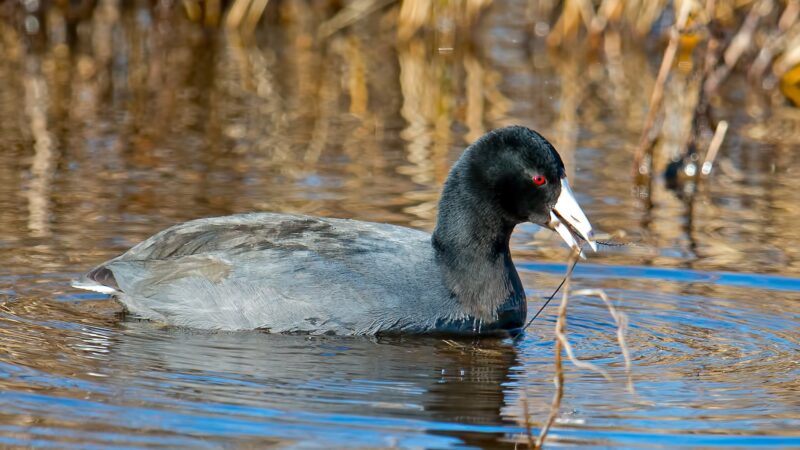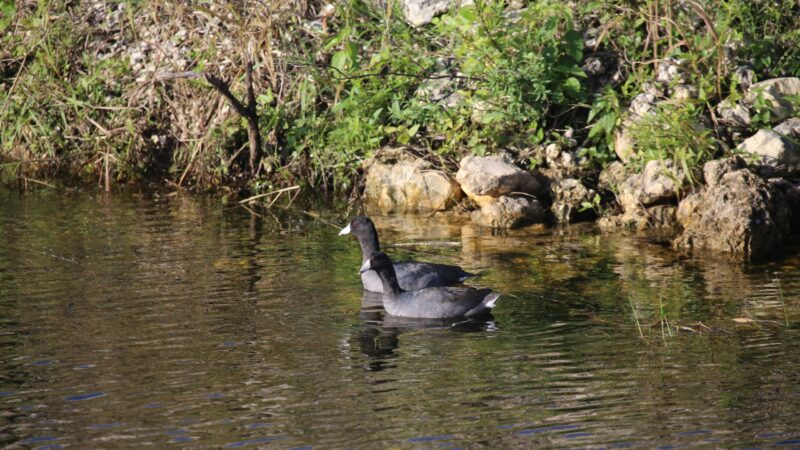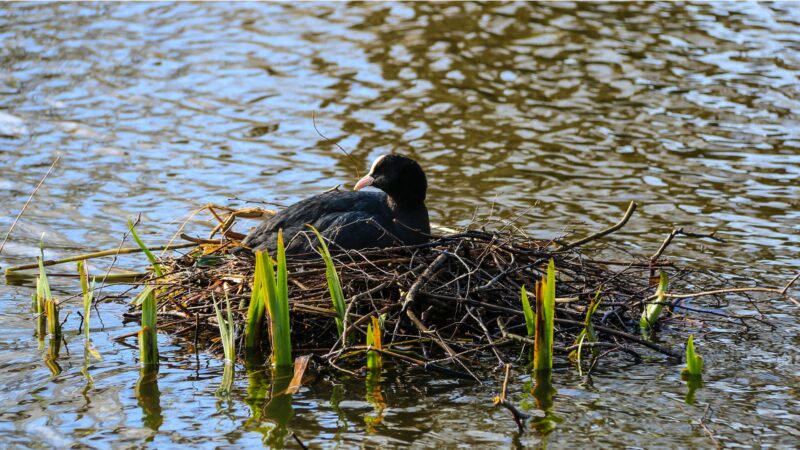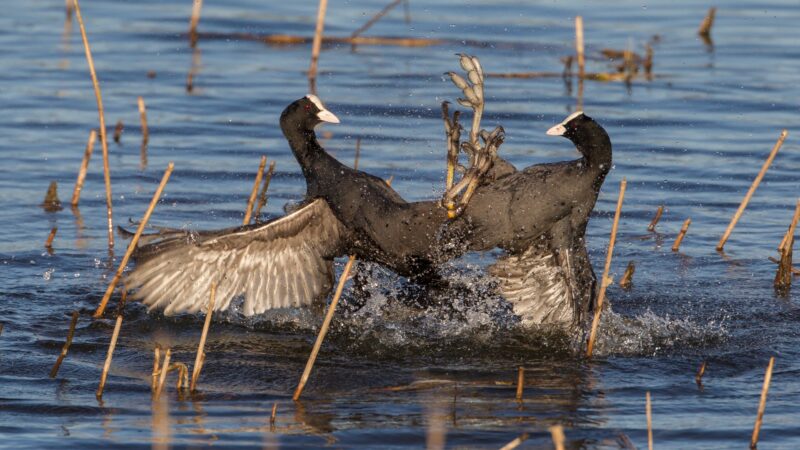Popularly known to invade wide, open spaces, it won’t be a surprise if American Coots suddenly appear on your lawns, gardens, and yards to wreak havoc into your otherwise peaceful, bird-free lives. Get rid of them quickly or else you’ll have a colony in your hands.
So, how to get rid of American Coots? Use two or more of the following methods for the best results: modifying their habitats to make them look less attractive, excluding the birds, and using visual or auditory bird repellents.
This guide discusses everything you need to know about American Coots, identifying them, ways of getting rid of them, and effective ways of preventing them from coming back. Read further for more!

What Is an American Coot?
Appearance
The American Coot (Fulica americana) is a plump-bodied waterbird characterized by its rounded head, dark gray overall plumage, white tail patch under its tail, white sloped bill edged with red or black, and red eyes. The average length of an adult bird is 15.5 to 17 inches while they weigh around 600 to 700 grams.
It also has short and rounded wings, making it hard for them to take off from the ground but once they are in the air, they can fly as efficiently as any other bird species. Compared to other waterfowl with webbed feet, the American Coot has lobed toes that allow them to be powerful swimmers and divers.
Habitat

They reside in or along freshwater habitats such as ponds (both man-made and naturally occurring), lakes, and marshes but they may be found occasionally in brackish water. Coots can also be seen in lake edges, reservoirs, sewage treatment ponds, saltmarshes, and reservoirs.
Feeding
Coots follow an omnivorous diet that is largely composed of aquatic plants such as eelgrass, algae, sedges, duckweed, waterlilies, wild celery, and water milfoil. When they are foraging on land, they like to eat terrestrial plants, grains, and leaves. Additionally, they also consume insects such as dragonflies, beetles, snails, and crustaceans.
Behavior
They are highly social birds that prefer living in flocks that can be made out of a thousand individual birds, especially during winter. Coots are slow and picky while foraging both on land and in water. Additionally, they are also aggressively territorial and can become quite noisy.
When flying, they can get quite clumsy as they find it difficult to take off. They are also known to steal food from other waterfowl such as ducks. Although they are a migratory species, they do not follow a strict migration pattern since they flock depending on the weather.
Related: How to Get Rid of Muscovy Ducks | Effective Techniques and Considerations
Nesting

The nesting season usually begins around May to June, with both males and females working together to construct a nest. They typically place it near the edges of waterways with a built-in ramp for their nestlings that creates a path toward the water.
Reproduction and Life Cycle
Coots generally breed once a year, laying between 8 to 10 eggs per clutch. The eggs hatch after about 23 days, and the young coots fledge in about 7 weeks.
The breeding season generally happens only once a year. Female coots lay 8 to 10 pink, brown-spotted eggs per clutch, which hatches in 23 days after being laid. The males take turns with the females in both incubating and taking care of their young.
Nestlings are able to dive at 1 month of age and at 5 to 6 weeks, they are now able to fly. They reach full maturity and independence from their parents after 2 months of age.
Related: How to Get Rid of Grackles | Proven Tricks to Repel Them
Are Coots Known to Enter Homes or Yards?
Generally, these birds like to stay close to waterways as much as possible and don’t usually stray away from them. However, they may occasionally wander into lawns, gardens, and yards that are close to their habitats, especially if it is an open space for nesting and has easy access to food.
Do Coots Harm People or Property?

Yes, as they are a naturally aggressive species. They may cause damage to gardens, lawns, and land crops that they forage on. Additionally, they can leave behind fecal droppings that are an unpleasant sight to see and can harbor potential parasitic diseases.
Related: How to Get Rid of Purple Martins | 6 Tips for Successful Bird Control!
How to Get Rid of Coots?
Getting rid of coots involves the following methods: habitat modification, exclusion, and visual or auditory bird repellents. For more efficient results, it is recommended that you employ a combination of these methods.
1. Habitat Modification
Coots utilize urban and suburban areas such as residential areas, parks, and golf courses for nesting, foraging, resting, and loafing if they are adjacent to agricultural lands. As such, modifying these sites can lessen bird prevalence.
Consider the following methods when changing coot habitat:
- Install tall or large vegetation that can obstruct the view of coots, such as shrubs, trees, or aquatic vegetation. This discourages them from walking straight into water sources.
- Reduce food in the adjacent agricultural area that is preferred by the birds such as succulent grasses.
- Regularly mow your turfgrass at a height of 8 inches or more.
- Plant water lilies on your lakes or ponds to prevent the birds from moving into the water or to slow their movements while they are in the water.
- If you live in a place with a cooler climate, turn off any water aerators you have in your water source and allow it to freeze.
- Remove any structures that can provide support for coot nests such as platforms.
2. Exclusion Techniques
Installing barriers that block the entry and walking access of coots into water sources and residential areas can reduce coot prevalence in your area.
Consider the following methods:
- If possible, vertically straighten the banks of ponds by up to 30 inches. You can also place large rocks or boulders along the pond edges to make entry even more difficult.
- Install barrier fencing made out of poultry wire, woven wire, chain link, plastic snow fence, wire strands, pickets, or netting. It should at least be 30 inches in height, with 2 to 3-inch openings.
- You can also install energized fences which can send an uncomfortable but otherwise harmless shock into the coots when they touch its wires.
- Cover ponds with netting made preferably of nylon since it is a highly durable material but polypropylene and polyethylene can also work. Make sure it is UV-resistant and anchored onto the ground using steel poles.
Related: How to Keep Birds Away From Your Car? | Control and Prevention
3. Visual or Auditory Deterrents
These include predator kites, scarecrows, or silhouettes, reflective tape, eyespot balloons, high-intensity lights, lasers, radio-controlled model helicopters, aircraft, and boats. They are effective but only for a short period. As such, they must be used in combination with habitat modification or exclusion techniques.
- PREVENT BIRDS FROM LANDING: Bird B Gone's Reflect-A-Bird is a...
- MULTIPURPOSE APPLICATIONS: Reflect-A-Bird is not only easy to use...
- WEATHERPROOF DURABILITY: Crafted from high-quality outdoor-grade...
- SLEEK & ADAPTABLE INSTALLATION: Featuring a sophisticated design...
- TRUST BIRD B GONE: A leader in avian control products, Bird B...
Coot Repellents | What Are the Best Products to Scare Them?
Getting rid of coots in a humane way includes the use of the following repellents:
- Reflective tape, material, and other objects that are shiny or glossy
- Bird-frightening balloons such as eyespot balloons
- Predator scarecrows, silhouettes, and other decoys such as fake hawks, coyotes, alligators, eagles, foxes, raccoons, and skunks
- Measures 15.7 Height x 7 Width. Made of sturdy molded plastic and...
- Just put the hawk in a visible location such as a tree or shrub....
- Hawks are the natural predator of birds and destructive living...
- Eco-friendly and wildlife friendly, get rid of birds and...
- Tips: 1. Please note that this hawk is for outdoor decoration,...
- Lifelike Coyote Decoy: The Bird-X 3D Coyote Decoy is a lifelike...
- Versatile Protection: With realistic markings and a fur tail that...
- Safe and Humane: Our decoy is a safe and ethical method that...
- Wide Coverage Area: Covering up to 1 acre of land, this predator...
- Easy-to-Install Decoy: Simply plant the stake attached to the...
- Ultrasonic sound devices that emit high-frequency sounds that irritate birds or bird sound dispersal systems that broadcast distress calls
Use these coot repellents at separate times or combine them to generate an effective, multi-sensory experience for the birds.
How to Prevent Coots From Coming Back?
Sanitation is the best way to prevent coots from nesting, foraging, and resting in your lawn, yard, or garden. Regularly clean and tidy up your property by disposing of any potential nesting materials and sources of food. Always inspect your area for any increased coot activity and keep utilizing the repellents stated above.
Related: How to Keep Birds From Nesting on Porch? | The Effective Guide
Interesting Facts About the American Coot
- Although they resemble ducks, coots are not ducks nor are they chickens. In fact, they belong to an entirely separate order in the waterfowl family.
- Coots are amazing swimmers but are weak fliers. They are considered one of the clumsiest marsh birds and are even called “splatterers.” When attempting to fly, they first scramble across the water for a head start then flap their wings for takeoff.
- Coots would sometimes lay their eggs in the nests of other individuals or species in a practice referred to as brood parasitism. Since American Coots are quite aggressive, other waterfowl pointedly ignore laying eggs in the former’s nests.
- Directly after hatching, coot chicks will have a rusty-colored, red-spotted head and a red bill. As they grow older, these colors will fade and become dull.
- Coots have a unique “tipping-up” feeding behavior, where they dive partially underwater to reach submerged vegetation while keeping their rear ends visible above the water’s surface.
- American coots, like ducks, partially dive into the water with their rear ends on the surface of the water while foraging.
Key Takeaways
Since coots are known to invade and potentially damage lawns, gardens, and yards, it is of utmost importance that you get rid of them as quickly as possible by changing their habitats, excluding them, and using visual or auditory bird-deterring devices.
List of Sources
- All About Birds. (n.d.). American Coot.
- Audubon. (2021). American Coot.
- BirdWeb. (n.d.). American Coot (Fulica americana).
- Bridgman, A. (n.d.). Fulica americana: American coot.
- Cornell Lab of Ornithology. (2021). American Coot.
- Cummings, J. (2016). Geese, Ducks and Coots.
- Ehrlich, P. R., Dobkin, D. S., & Wheye, D. (1988). American Coots.
- Van Way, V. (1986). Approaches to Coot Management in California.
- How to Get Rid of Copperheads | Practical Guide - August 27, 2023
- How to Get Rid of Corn Snakes | What Makes Them Aggressive? - August 27, 2023
- How to Get Rid of Alligators | Safety Measures and Removal Methods - July 16, 2023



